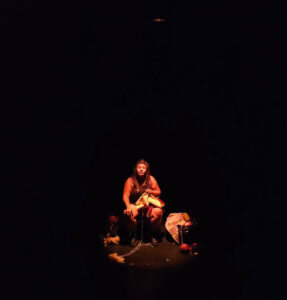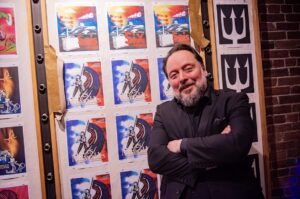The premise of Zuppa Theatre’s interactive theatrical scavenger hunt experience This Is Nowhere is that a legend exists that in 1968 a secret organization called The Nowhere Collective met to draft a blueprint of a futuristic vision for Halifax. Their work has largely been lost, and their blueprint never came to fruition. Fifty years later, Zuppa Theatre is inviting Haligonians to take to the streets, with the help of a GPS-led app, and to experience an array of different theatrical happenings throughout the downtown of the city, and to help in the creation of a new blueprint for Halifax.
You begin your quest at an appointed time anywhere that you would like in the downtown of the city. You open up the Zuppa Theatre This Is Nowhere app and you are given clues to guide you through the city toward one of twelve different performances that are performed by actors on loops over three hours. The app is set up to send people to all twelve in different orders so everyone’s journey seems to be slightly different. My understanding is that there is not enough time in the allotted three hours of performance time to get to all twelve. I was only able to see seven. Each performance revolves around a certain theme, Love, Art, Justice, Commerce, for example, and after each performance you are prompted to type into the app your ideas about how best to incorporate this theme into the blueprint for a vision for a futuristic Halifax. Sometimes, you hear recorded bits from the 1968 blueprint discussions. Sometimes you have encounters while you’re walking from one performance to the next, that is, if your head isn’t buried in your phone screen. After three hours the app leads you to a meeting place where you are united with your fellow adventurers and the new blueprint you have created together is revealed.
This Is Nowhere is a continuation of Zuppa Theatre’s interest in creating theatrical work that incorporates interactive technology following The Archive of Missing Things, which took place last year and had participants working through the performance piece while sitting at a computer at the Killam Memorial Library. My experience with both shows, given my personality, was similar, in that I am both very suited to this type of theatre experience, and yet also continually challenged by it. I tend to become, perhaps, too preoccupied and competitively focused on the “objective” (which for This Is Nowhere was to attempt to find as many of the twelve theatre locations as possible), which, under the time crunch, tends to make me so focused on the destinations that I don’t slow down enough to enjoy the journey. I think This Is Nowhere is set up to encourage participants to take their time to be hyper-aware of the city- to notice things that maybe they hadn’t seen before, to be open to having encounters with the wanders who are scattered throughout the downtown, and to explore and find new places. It’s also set up to encourage audiences to sit and contemplate the theatre they have just seen and there are interactive stations set up as well to encourage participation and play and engagement. You are continually choosing between whether you want to spend your time soaking in every opportunity you are given, or whether you want to move on to the next thing. I found myself wanting to keep moving, but I’m envious of those who were able to slow down and relish the experience more as it was unfolding. It was also raining quite hard throughout my journey, which likely made me more focused toward getting from one building to the next as quickly as possible.
Alex McLean has developed the concept for the show with Stewart Legere, Kathryn McCormack, Liliona Quarmyne, and Ben Stone, and they direct and coordinate a company of forty actors throughout the city. Some of the performances are extremely intimate. Briony Merritt, for example, sat across from me at a table in a small room and spoke directly to me, in a way that seemed so natural and like a conversation that I felt awkward not responding back to her. Mary Fay Coady gave a beautiful performance in a living room as a woman in the devastating throes of heartbreak. Jilly Richard, Zya Langdon, Ed Thomason and Steve Baker capture beautifully the sometimes awkward conversations between a young child and her grandparent as they try to connect with one another. I’m not sure whether Gil Anderson repeated the same monologue on a loop out loud, or whether we were listening to her prerecorded voice on our headphones and she was lip syncing to herself, either way, it was a very unique way to experience a monologue. It definitely felt like we were overhearing a private conversation happening in a public space. The writing, primarily by Kate Cayley, oscillates nicely between the everyday and the profound, which helps participants think about what ideas they would like to add to the Halifax blueprint. There were also ethereal performances from dancers Jacinte Armstrong, Kendra Armstrong, Molly Johnson, and Liliona Quarmyne and from Xara Choral Theatre and the Nova Scotia Mass Choir.
I found the more that I heard snippets from the 1968 blueprint, and the more I began to consider Halifax’s future, and indeed humanity’s future, from both an idealistic and pragmatic perspective, the more aware I felt of the massive responsibility and the incredibly difficult task it is to plan a city, in the hopes that you will be respecting the people who live there. We were asked, for example, what the place of belief would be in our city, as we sat in St. Paul’s Anglican Church, the oldest church in Halifax. I would never advocate for the tearing down of this building, I love old buildings, I see this one as a defining piece of Halifax’s history, but at the same time I abhor organized religion’s role in the genocide of millions, the destruction of cultures and histories and languages. If in your ideal vision for the city you imagine a place without religion, how, if not through Fascism, would you rid the city of its congregations? Or, do you imagine a place where religions exist, but with a genuine respect and sense of true equality among them? Is that possible? I don’t know. The same sort of questions surrounded me when thinking about the role for authority in the future city. Certainly I would want less surveillance of racialized communities, no more racial profiling, police brutality, and to deconstruct the systemic white supremacy and misogyny that is inherent in all our systems of power. Some sort of law enforcement would be necessary to keep people safe. Halifax has a history of destruction, both by violent riots and wartime disasters, we all benefit from rules and regulations, but how do we ensure that they are being enforced fairly? Where do we start our deconstruction?
It’s easy for us to say we want more arts spaces. We do need more arts spaces. It’s easy for us to say we want fewer condo buildings and more affordable housing. In fact, the first thing I typed into the blueprint was “Leave the old buildings alone! Less Fucking Condos!” Those aren’t easily fixed either, I feel like we’re usually yelling into a void about them, but This is Nowhere really opened the floodgates and encouraged us to think beyond just the physical buildings, and to ask what do we want our city to be, how do we want it to feel, how do we want it to love and believe, and think and feel, what do we want it to want and know and understand? I found the constant conundrums I faced overwhelming, and I’d be lying if I didn’t admit that at times the more difficult I found the answers to be, the more complex I realized that the changes I want to see would be, practically, the more discouraged I felt. But, I think it’s important for us to understand how complex this process is, because, honestly, it’s the same complexity that our governments face in trying to make decisions for which direction our city should grow in. If we want progress for Halifax, I think we have to be willing to work towards it. We can’t rely on anyone else to do it for us. We have to delve into the issues, regardless of how complicated they are, and begin to start unravelling them piece by piece and step by step.
It’s impossible for me to not make the connection between this show and Susan LeBlanc, Zuppa Theatre’s Co-Artistic Director (with McLean and Stone) and MLA for Dartmouth North. We have a bridge between the place where we wander around Halifax, the dreamers and the planners, the artists and the lovers, the believers and adventurers, and the place where the decisions for our province are made. Hopefully, projects like This Is Nowhere will inspire the creation of more bridges, between artists, between communities, between activists, between citizens and members of all three levels of government, and between neighbours. We live in a beautiful place with a rich and complex history. We all should be the collaborative authors of its future.
Zuppa Theatre’s free and sold out run of This Is Nowhere took place in Halifax, Nova Scotia (K’jipuktuk) between September 26th and 30th.
Find Zuppa Theatre on Facebook, Twitter & Instagram (@zuppatheatre).







